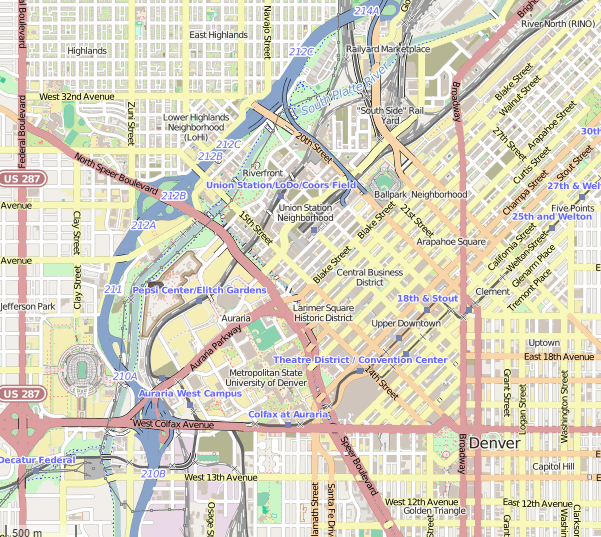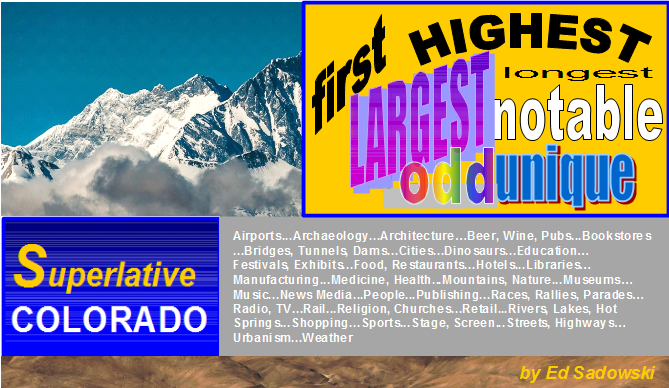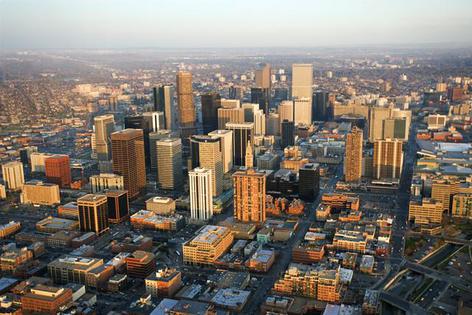Map: © OpenStreetMap contributors
Another Ed Sadowski creation
ED SADOWSKI
RETAIL
Airports...Archaeology...Architecture...Art...Beer, Wine, Pubs... Bookstores...Bridges, Tunnels, Dams...Churches, Religion... Cities... Dinosaurs... Education...Events, Festivals...Food, Restaurants..Hotels... Libraries... Manufaturing...Health, Medicine...Mountains, Nature... Museums... Music...News media...People...Publishing...Races, Rallies, Parades...Radio, TV...Rail transit...Retail...Rivers, Lakes, Hot Springs...Sports...Stage, Screen...Streets, Highways, Infrastructure... Urbanism...Weather, Climate
Downtown
Denver
.
RETAIL
Baur's Confectionary
16th Street Mall
Denver Pavilions
Larimer Square
Morey Mercantile Building
Rockmount Ranch Wear
Tattered Cover Bookstore
Walgreen's
Woolworth's
16th Street Mall ///////////////////////////////////////////////
When most pedestrian malls have failed, the 16th Street Mall is one of the country’s most enduring and successful: also one of the longest at 1.42 miles (2.3 km) long, most of it pedestrian- and transit-only.
The Mall stretches from Broadway Avenue to the Millennium Bridge (from which another two bridges connect pedestrians over railroad tracks and I-25 to Highland). Designed by the renowned architect I.M. Pei, the Mall opened in 1982, and has been lauded by the Urban Land Institute.
It is lined with over 150 restaurants, outdoor cafes, boutiques and retail centers Denver Pavilions and Tabor Center, and it runs one block from Larimer Square. It is lined with over 200 trees, unique lighting fixtures and “carpet-runner” red, white and gray granite pavers resembling a rattlesnake’s back.
At one time 16th Street, the “main street of downtown,” with multiple department stores, was the city’s retail center before the advent of suburban shopping malls. It was this street that boasted the world’s largest Woolworth’s variety store, part of the Rocky Mountain region’s premiere shopping experience. While the street’s oldest retailers have moved away or gone out of business, a few remnants have stayed, such as the nation’s fourth oldest Walgreen’s, still at its same location since 1949.
Baur's Confectionary Company /////////////////////
16th & Lawrence
GONE INTO HISTORY
A sweet claim by Denver is the world’s first ice cream soda, also called a “float.” This happened in 1870 at Baur's first location at 16th and Lawrence, according to a newspaper interview with Otto Baur shortly before his death.
This claim is disputed by several other US locales, most notably Philadelphia. Credit is most often given to the city of Philadelphia, with a date of 1874. Philadelphia may rightly claim to have popularized the ice cream soda because Denver was a sleepy little frontier town whose gastronomical impact on the nation would be invisible compared to Philadelphia, a major city in the populous East.
The German-born owner of the corner candy store concocted the treat in an attempt to accommodate a regular customer. The patron would come in every morning for a glass of cream shot with seltzer water. One morning the customer arrived before the cream had been delivered to the establishment, so Baur suggested that he try some ice cream with the seltzer water instead. The result was a happy surprise, and the ice cream soda was born. Its fame was said to spread far and wide and Baur’s established a national reputation. Later the Confectionary moved to 1512 Curtis Street, the Baurs adding a restaurant there, as well as bakeries and branches throughout the city. Baur’s went out of business in 1970. The Baur’s name was revived in the historic Baur Building in 2015 with the opening of Baur’s Restaurant.
The Denver Pavilions /////////////////////////////////////
16th and Glenarm, 16th Street Mall
While most pedestrian-only downtown street malls in the country have failed, Denver's 16th Street Mall is one of the unusual success stories that shine.
One contributor to this success is the Denver Pavilions, a three-story, 350,000 square-foot mall within a mall at 16th and Glenarm.
The Denver Pavilions retail/entertainment center opened in 1999 in downtown Denver, bragging that “no other city in the nation boasts this many of the world’s most innovative concepts in one location,” and “we’re much bigger and broader than other entertainment centers.” A retail expert stated, “I don’t know of any city that is putting it together the way Denver is.” The Denver Pavilions boasted the highest concentration anywhere of an array of vibrant, top-of-the-line entertainment, restaurant and retail tenants to create a spectacular shopping center synergy.
The unique “urban entertainment complex” opened with 50 merchants (now about 40 shops, restaurants and entertainment venues) spanning two blocks on the 16th Street Mall, built to co-exist architecturally with the surrounding historical structures in the area. It was said to be the first project of its kind to be placed in a downtown location.
The opening day all-star Pavilions lineup included the Hard Rock Café, NikeTown, Virgin Megastore, Wolfgang Puck Café, and the nation’s first Benetton Sportsystem store. A 15-screen United Artists cinema with stadium-seating brought movies back to the heart of downtown after a 16-year absence.
Today, of these big-name headliners, only the Hard Rock Café is still at the Pavilions. But, with a few speed bumps along the way, Pavilion has re-injected fresh and trendy new names to attract shoppers. New-to-Colorado stores like Colorado's first European-based clothing store H&M and Japanese private-label apparel specialty retailer UNIQLO, Francesca’s women's boutique and the country's third futuristic-like For The Win adult-focused arcade.
Denver Pavilions has more than met its opening-day hype in 1999 and is succeeding while other malls are not, bucking the tidal wave of struggling, failing malls.
One secret to this bricks-and-mortar retail success has been selling "experiences" that online shopping cannot deliver. A millennials-centric showcase for the alluring ultra-cool and the next hottest big brands mixed fresh with the established and familiar is alive and kicking in this hip mall within a mall.
Larimer Square //////////////////////////////////////////////////
Larimer St., between 14th and 15th
Larimer Square, “Denver’s most historic block,” has been the national model and prototype for the revival of downtowns and urban renewal.
Larimer Street was Denver’s first main street, but eventually became one of the country’s most infamous skid rows.
It all after changed after developer Dana Crawford and investors in 1965 stopped the block’s slated demolition, reversing the massive destruction of downtown buildings in the name of urban renewal. The project has been recognized nationally as one of the first successful preservation projects of its kind. Crawford helped found Historic Denver, Inc., launching the preservation movement in Denver.
The Larimer Square rebirth of restaurants and retail became the first project of a wave that made LoDo’s success what other cities have aspired to. The fruit of this effort is that the 127-building, 26-block LoDo Historic District is one of the country’s largest concentration of Victorian and early twentieth-century buildings, a marvelous transformation of former brick warehouses and mercantile buildings.
Current Larimer Square tenants include The Comedy Works, named by USA Today as one of the top five comedy clubs in the nation.
Morey Mercantile Building ////////////////////////////////////
16th and Wynkoop (SE corner)
Superlatives: "the most elegantly appointed business house," home to the largest mercantile/grocery business in the West; site of the rare oddity, "door to nowhere."
Chester Stephen Morey was born in Wisconsin in 1847, went to college in Chicago, where he then started out in the grocery business. He was a Civil War veteran who was on the field at Appomattox when Lee surrendered to Grant. In 1872 he moved to Colorado to recover from tuberculosis, and ended up building a wholesale empire.
His six-story Chester S. Morey Mercantile Building, built in 1896, is now home to the Tattered Cover bookstore, a restaurant, wine shop and loft apartments. At the turn of the century, the Morey Mercantile was once a bustling distribution giant, the largest grocery business in the West in terms of sales, territory and number of employees. It was considered to be one of the jewels of "Warehouse Row," as Wynkoop Street was called.
Like other large enterprises in the area, the building combined storage and production with showrooms and corporate offices, and also retail sales to the public. On site was a spice grinding mill, roasting plant, extract laboratory and print shop.
Morey handled a complete assortment of food products such as fish, cheese, cereals, macaroni and established its own Solitaire brand of food products that included canned goods and coffee. Morey published a popular cookbook, The Solitaire High Altitude Cookbook, tested in its second-floor kitchens. In addition, Morey sold household items such as brooms, matches, cutlery, appliances, writing tablets, as well as cigars, chewing tobacco and snuff.
The double-wide alley off 16th Street accommodated railroad tracks with loading docks for easy access to railcars. A storefront in the alley handled retail sales. Both railroad tracks and cobblestones are still visible in places. The "door to nowhere" still fronting Wynkoop was the second-story entrance to an elevated walkway that connected to the 16th Street Viaduct (built in the 1880s, was demolished in 1990 as the 16th Street Mall was extended).
Swashbuckling film star Douglas Fairbanks, "the first king of Hollywood," worked at Morey as an office boy before being fired for sliding down an elevator rope in the presence of Mr. Morey, who forbade such unsafe acts. His older brother remained at Morey for his entire career and was visited on numerous occasions by Douglas and his wife and fellow Hollywood star Mary Pickford.
Morey pioneered Colorado's sugar beet industry and became president of Great Western Sugar Company, turning over Morey Mercantile to his son, John. In 1956, Morey Mercantile was sold to Consolidated Foods Corporation, a national grocery company in Chicago.
Morey was a civic leader passionate about education, instrumental in founding Manual High School. Morey Middle School was named after him.
Rockmount Ranch Wear ////////////////////////////////////
1626 Wazee Street
Rockmount is the birthplace of western shirts, invented and popularized by founder Jack Weil. In 1946 Weil created the first snap-button cowboy shirts with their distinctive pockets, distinguishing cowboy fashion as purely American. The Rockmount signature design with diamond snaps and sawtooth pockets is considered to be the longest production style shirt in America. Also introduced by Rockmount were the first commercially-produced bolo ties. Rockmount is proudly one of the last predominantly US brands.
His innovative western clothing lines have been embraced by celebrities and plain folks alike worldwide (the Ranch Wear store is popular with big-name stars when they are int town). Directing his business daily until his death at age 107 in 2008, Weil was known as the world’s oldest CEO. Rockmount is an institution as much as an enterprise, and its store and museum offer a genuine slice of Americana. Rockmount’s 1909 building in LoDo, an example of Prairie Style architecture, was advanced for its time.
Tattered Cover Bookstore ////////////////////////////
16th and Wynkoop and Union Station
"The best general bookstore in the United States": that's how the Tattered Cover was hailed in 1989 by The New York Times. The article referred to its former magnificent four-floor Cherry Creek location, which was one of the largest independent bookstores in the nation.
In terms of being one of the world's finest and largest independent bookstores, one of Denver's most beloved institutions, that part has not changed. What has changed is that the Tattered Cover, first on the scene in 1971, has expanded to a total of five locations in Denver. It has weathered the competition of national book chains, Amazon and the ebook revolution. The death of print books and bookstores was greatly exaggerated, having made a comeback, and the Tattered Cover is leading the way.
Walgreens ///////////////////////////////////////////////////////
16th and Stout
If you had left Denver in the 1960s and returned today, you would be shocked by the change in downtown. 16th Street would be unrecognizable, because the big retail names would be mostly gone from view as you walk down the sidewalks.
One store name still remaining is the corner Walgreens at 16th and Stout. The second-largest pharmacy chain in America has had a presence in downtown Denver for decades, since 1949: in fact, it is the country's fourth-oldest Walgreens location.
In 2015 the downtown store saw a facelift and expansion on the first level for a total of 7,000 square feet. It also became the most diverse Walgreens, with the addition of groceries and eats to go, including Denver’s lowest-priced sushi.
Woolworth's //////////////////////////////////////////
16th and Champa
GONE INTO HISTORY
The F.W. Woolthworth Co. was the most successful five-and-dime store, the largest department store chain in the world. Its downtown Denver location in the Symes Building became “the world’s largest variety store” after its expansion in 1963. Its 174,000 square feet stretched from 15th to 16th streets on two levels, taking up half a block.
The store boasted two miles of display counters within 58 shops and departments offering more than 50,000 items of goods for the entire family and whole home, ranging in price from a few pennies to upward of one hundred dollars. These departments carried apparel for the whole family, housewares and home furnishings, garden, pet, camera and music shops, and toys. Also in-house were a utility bill-paying station and total restaurant/ with a seating capacity of 700 people. Within the restaurant area was a sandwich counter, named the “Chuck Wagon” in salute to Colorado’s famous livestock industry. Hoagies and pizza were included in the menu.
In 1994, following the closing of downtown’s other department stores, the store was shut down, three years before the Woolworth corporation’s demise.



